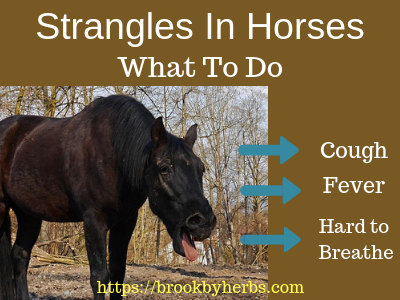
Strangles in Horses - What To Do
Share
Strangles in Horses – What To Do

Strangles in horses is more common than you would think and it’s a problem that can be deadly if not taken care of immediately! This Streptococcus equi is a very contagious upper respiratory tract infection that causes the horses’ lymph nodes to swell. This swelling is just the beginning of the problems to come.
When this happens, it can compress against the pharynx, larynx, and even the tracheas. Your horse then has their airway obstructed causing them to cough and have trouble breathing. Once the horse has trouble swallowing or breathing they experience exactly why this disease is called the strangles!
Strangles in horses also causes fevers that can reach 106 degrees and a yellow nasal discharge that runs from the nose and the eyes.
There are times when these lymph nodes can become abscessed causing further distress for the horse and more imminent danger. These abscesses can pop open spreading the disease even further!
What Causes Strangles in Horses
Strangles is spread when the nasal discharge from infected horses contaminates their feed troughs, bedding, tack, grasslands, etc. Anywhere the infected horse goes is likely to be infected.
Isolating the infected horse is the first step after calling the vet. Why? The bacteria can be spread around for up to six weeks, so the sooner the horse is isolated, the better. You want to stop or slow down the spreading of strangles as quickly as possible to save other animals from harm.
Once the horse is isolated workers and owners should go about trying to clean up the infected areas of the stalls and barns. First and foremost is keeping hands washed with antiseptic soap after handling the feed or horse that is infected.
The healthy stock should always be fed and watered first, and the infected horses last. All troughs, water buckets, and feeding items should be cleaned and disinfected before feeding the healthy horses each day.
How is Strangles in Horses Diagnosed?
You will need a vet to confirm a strangles diagnosis. They will test the horse by taking a swab from their nasal cavity. The results of this test will let you know if your horse really has the strangles.
Strangles has an incubation period of one week, but there have been cases where it takes up to three weeks.
- Clinical Signs of Strangles in Horses
- Nasal or eye discharge
- High temperatures
- Enlarged glands, usually in neck or head
- Coughing
- Difficulty swallowing
Is There Prevention for Strangles in Horses?
There are vaccinations available against strangles, but the vaccination alone is not absolute. While being vaccinated will certainly assist in spreading the disease during an outbreak it’s not a perfect cure.
If your horse has a strong immune system, the vaccines have a much greater shot at keeping the strangles at bay. Healthy foods and the right organic supplements can increase your horses’ chance of fighting any sickness.
Watch daily for signs of strangles in horses with your horse or herd and be ready to take action!
Click here to buy our Immune Booster supplement.
